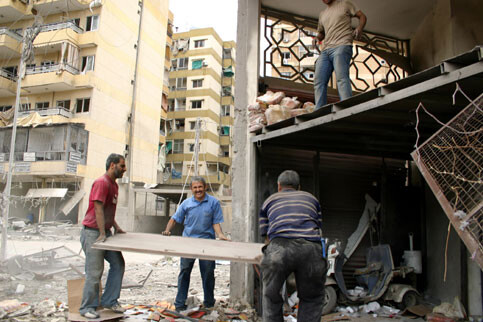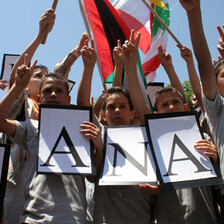The Daily Star 21 July 2006

Destruction in Hay Madi, a southern suburb of Beirut, after an Israeli airstrike. Photo taken 20 July 2006 (Hugh Macleod/IRIN)
The fury of Israel’s offensive in Lebanon has more than a few observers shaking their heads. The vast majority of Western media reports do not accurately portray the fact that the vast majority of the dead are civilians, most of them women and children. A Reuters dispatch this week described Israel’s choice of targets as “puzzling,” but for the most part Western television viewers, newspaper readers, and Web surfers are reading highly sanitized versions of the news, spun in such a way as to dilute the brutality of the Israeli onslaught and especially to ensure that blame is placed squarely on Lebanon in general and Hizbullah in particular.
Of course there are brave and honorable Western journalists working here, and many of them are determined to tell the truth about what is happening. One has to assume, therefore, that what the decent ones report is being heavily edited somewhere along the line before it gets to the consumer. This is presumably intended as a prophylactic against the inevitable charges of “anti-Semitism” and resultant drops in advertising revenues that will follow unvarnished coverage of Israeli brutality. The product of this regime of fear has been a generation of biased reporting that portrays the Jewish state as weak when it is very strong, moderate when it is frequently extremist, democratic when it is often theocratic, liberal when it is commonly draconian - in short, “Western” when it is anything but.
Coverage of the current conflict is a case in point. The two most commonly watched English-language news channels available in Lebanon are CNN and the BBC. With few exceptions, their reports are filed by reporters standing in the relatively safe and comfortable confines of Downtown Beirut, the picturesque showcase of Lebanon’s now-aborted recovery from its 1975-90 Civil War. There has been no damage in this part of the city thus far (although there are concerns that that step in the escalation process is rapidly approaching), so the very background is highly misleading about what is happening. Just a few kilometers away in Beirut’s Dahiyeh Junubiyyeh (southern suburbs), Israeli air strikes and naval gunfire have reduced entire neighborhoods to rubble. No one knows how many people are buried in these piles of shattered concrete and twisted steel, only that local residents would have had far less warning than Hizbullah members did about the beginning of so many ends - and that most of their escape routes were cut off by the destruction of roads and overpasses before the Dahiyeh itself became a target.
A similar situation exists in the southern third of the country, usually a half-hour bus ride from Beirut. Now it can take hours in either direction because vehicles cannot get through. Instead, people are shuttled from one giant crater to the next, where they walk across debris-strewn holes in the ground or wade through rivers once spanned by wrecked bridges to reach another taxi or mini-bus that will take them to the next impasse. Throughout the journey, their vehicles are subject to Israeli attacks, so many people stay home and try to “ride it out.” But a considerable number are subsequently convinced to run the gauntlet when the Israeli military warns them that they have “two or three hours” to leave their villages. On numerous occasions, such warnings have been followed less than an hour later by air or artillery strikes on civilian vehicles leaving the village. They keep leaving, though, because those who stay in their homes have frequently found out that the Israelis mean it when they say an area is about to become “unsafe” for civilians: Dozens of civilians have been killed in their own homes - with and without warnings beforehand. The message for these unfortunate people is that “nowhere is safe.” In fact, that is precisely what an Israeli general said in the opening stages of the offensive.
Why has the Israeli military singled out these two areas for punishment? Because they are populated primarily by the impoverished and largely disenfranchised Shiites who make up Hizbullah’s constituency. Multiple ironies are at work here. For one thing, the Dahiyeh’s 500,000-strong population consists largely of Shiites from the South Lebanon who have fled successive waves of Israeli “retribution” (i.e. collective punishment). When Palestinian militias attacked northern Israel from South Lebanon in the 1970s, one of Israel’s answers was indiscriminate bombardment. This drove tens of thousands of local villagers to Beirut, where they established the Dahiyeh.
For another, when Israel first invaded Lebanon in 1978 (not 1982, as typically reported in the Western media), many Shiites greeted them with rose petals. Life under the de facto rule of unruly Palestinian militias had not been easy, so despite the damage and casualties inflicted by Israeli ripostes, it was commonly believed that Israeli occupation might not be so bad. Then came 1982, when the Israelis rolled all the way to Beirut after promising Washington that they meant only to establish a 25-kilometer “buffer zone.” The carnage in the South was horrific, and the ensuing occupation included measures like the dismissal of local village elders in favor of appointed stooges and provocations timed to coincide with sensitive religious dates. The Shiites revolted, and Hizbullah was born.
Subsequent spasm of violence (the worst in 1985 and 1996), usually caused by tit-for-tat exchanges between Hizbullah and the Israeli military that spun out of control, displaced more and more Shiites, filling the Dahiyeh with an understandably resentful generation of young men determined to run no more.
All of this goes unmentioned on CNN. Its idea of “balance” is to make sure that each report about a new massacre of innocents in Lebanon is aired alongside one about civilian injuries or deaths from Hizbullah rocket strikes, even if the incident is 36 hours old. Only rarely do the reports in question mention that while the Dahiyeh is for all intents and purposes a giant refugee camp, northern Israel and the nearby settlements in occupied Palestine are prosperous areas with a substantial contingent of immigrants from places like the United States and Canada, many of whom voluntarily live illegally on occupied Palestinian land.
Hizbullah’s decision to snatch two Israeli soldiers evinced poor judgment and even worse timing, but the Israeli response has been out of all proportion to the original incident. The numbers speak for themselves. As of Wednesday evening, Israeli attacks had killed at least 292 civilians in Lebanon, while Hizbullah rockets had killed 13 noncombatants in the Jewish state. Lebanon has approximately 3.5 million people. On a per-capita basis, that means that as of Wednesday, the rough equivalent of 9/11 has happened every day here for eight days.
Related Links
Marc J. Sirois is the managing editor of The Daily Star, where this article was originally published.



